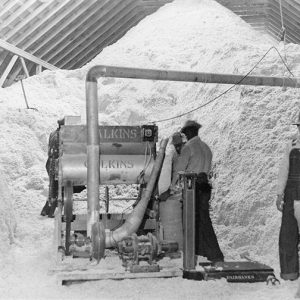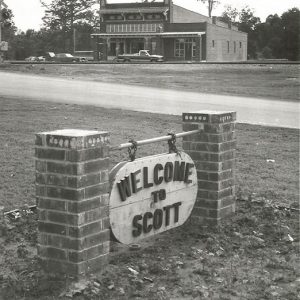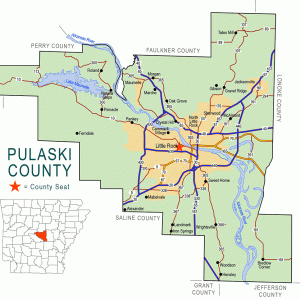calsfoundation@cals.org
Scott (Pulaski and Lonoke Counties)
Scott is a small community on the line between Pulaski County and Lonoke County, north of the Arkansas River. Surrounded by farmland and by oxbow lakes, Scott is also near two state parks and several historic properties.
Over the centuries, events such as floods, droughts, and—most recently—human construction have altered the path of the Arkansas River. Remnants of former sections of the river remain near Scott as oxbow lakes, particularly Bearskin Lake, Horseshoe Lake, and Willow Beach Lake. More than 1,000 years ago, a complex formation of mounds was created near what is now called Mound Pond. The site was farmed in the nineteenth century but was later preserved as Plum Bayou Mounds Archeological State Park.
Not only did the river create distinctive lakes, but it also provided rich farmland that was attractive to the first white settlers of Arkansas Territory. Chester Ashley was one of the first investors to acquire land in the area now known as Scott. John Scott, for whom the community is named, arrived in 1844. Thomas Steele began his plantation in the area in 1850.
In the summer of 1863, Federal troops approached Little Rock (Pulaski County) from the north, encountering resistance from Confederate forces at Brownsville (Lonoke County) on August 25 and at Bayou Meto—near present-day Jacksonville (Pulaski County)—on August 27. After scouting the area for a suitable place to ford the Arkansas River, Federal officers chose to cross the river near the present location of Scott. Trying to defend a dozen possible crossing points, Confederate forces were unable to prevent the Federals from crossing, although they did fire upon the pontoon bridge during the morning of September 7. This brief engagement is known as the Skirmish of Ashley’s Mills. On the morning of September 10, the Union army crossed the river, driving the Confederates before it. By the end of that day, Federal forces held the city of Little Rock.
The war and its aftermath forced changes in the plantation economy of Arkansas, but the promise of the rich farmland continued to draw settlers. James Robert Wayne settled on the Arkansas River south of Scott in 1870. The next year, the St. Louis Southwestern Railroad (known as the Cotton Belt) was constructed through the Scott area, although Conway Scott (son of original settler John Scott) had to be taken to court for the railroad to obtain a right-of-way through his land. The railroad depot was called Scott’s Station (or Scott’s Crossing) at first, but later the name was shortened to Scott. In 1912, Scott built a large brick building, intending to house a general store. The store later opened with different owners. A post office was added to the store in 1929.
In 1885, William Pinkney Dortch married into the Steele family. By 1904, Dortch had established a new plantation, centered around a mansion named Marlsgate, which was designed by architect Charles L. Thompson. James Robert Alexander, who had settled in the area in 1882, built Land’s End Plantation in 1925; its central house was designed by John Parks Almand. In 1905, a nondenominational congregation was formed, calling itself All Souls Church. The first minister to preach in the church was Methodist, but the congregation has been served by ministers from a number of different denominations—first by visiting preachers or circuit riders, but by resident ministers starting in 1934. The church building, like Marlsgate and Land’s End, is on the National Register of Historic Places.
Cotton had been the principal crop on Scott-area plantations, but Robert Dortch—the youngest son of William Pinkney Dortch—began to experiment with other crops, especially soybeans. He developed a hybrid cotton seed marketed as Roldo Rowden. In 1964, he opened a museum of farm equipment that had been used on the Dortch plantation. The museum was housed in the brick building that had been built by Scott in 1912. Dortch died in 1972, and the museum closed in 1978, but the Arkansas General Assembly voted in 1985 to fund the acquisition and refurbishing of the property. The state park, known as Plantation Agricultural Museum, opened to the public in 1989. In 1992, the Plantation Museum began hosting the Antique Tractor & Engine Show, a free event held the first Saturday after Labor Day that draws exhibitors, enthusiasts, and families to the state park to explore pre-1960 mechanized farm equipment and other small engines.
Six years after the Plantation Museum’s opening, local citizens began a group called Scott Connections. Using some historic buildings already in place and others that were transported from as far away as Hazen (Prairie County), they created the Scott Plantation Settlement to portray life during the nineteenth and early twentieth centuries in Arkansas. The organization offers tours of the historic buildings, and it also maintains an archival collection of materials related to Scott and the surrounding area.
Another noted landmark in Scott was Cotham’s Mercantile and Restaurant. Located in a former general store near Horseshoe Lake, Cotham’s was most noted for large hamburgers and desserts. However, fire destroyed the 100-year-old establishment on May 29, 2017.
Scott Elementary School is part of the Pulaski County Special School District.
Renowned psychologist William Sterling Hall was born in Scott in 1934.
For additional information:
Brown, George Alexander. Temple Mounds and Plantation Bells: Scott, Arkansas. Ashley Mills, AR: 1989.
Campbell, Donald K., II. “Scott’s School History.” Pulaski County Historical Review 62 (Winter 2014): 130–137.
Fletcher, Mrs. W. J. “A Brief History of the Community of Scott, Arkansas.” Pulaski County Review14 (September 1966): 55–60.
Knighton, Percy. “Scott Leads U.S. in Soybean Seed Production.” Arkansas Democrat Sunday Magazine, May 17, 1953, pp. 1, 5.
Schnedler, Marcia. “Plantation Life in Scott Won’t Soon Be Forgotten.” Arkansas Democrat-Gazette, May 9, 1999, p. 2H.
———. “Scott—A Taste of the Old South.” Arkansas Democrat-Gazette, February 11, 1996, p. 2H.
“Scott-Related Oral Histories.” 1970s. Audio online at Butler Center for Arkansas Studies, Arkansas Studies Research Portal: Scott Oral Histories (accessed June 8, 2022).
Wolfe, Ron. “A Lot in Scott.” Arkansas Democrat-Gazette, March 19, 2017, pp. 1E, 6E.
Steven Teske
Butler Center for Arkansas Studies
 All Souls Church
All Souls Church  All Souls Church
All Souls Church  Col. Baucum Road
Col. Baucum Road  Cotham's Mercantile
Cotham's Mercantile  Cotham's Mercantile
Cotham's Mercantile  Cotton Seed
Cotton Seed  David D. Terry Lock and Dam
David D. Terry Lock and Dam  Robert Dortch
Robert Dortch  Lonoke County Map
Lonoke County Map  Marlsgate
Marlsgate  Plantation Agriculture Museum
Plantation Agriculture Museum  Plantation Agriculture Museum
Plantation Agriculture Museum  Pulaski County Map
Pulaski County Map  Scott Depot
Scott Depot  Scott Plantation Settlement
Scott Plantation Settlement  Scott Plantation Settlement Building
Scott Plantation Settlement Building 




William Sterling Hall was my uncle.